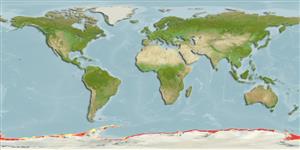>
Perciformes/Notothenioidei (Icefishes) >
Nototheniidae (Cod icefishes) > Trematominae
Etymology: Trematomus: Greek, trematos = hole + Greek, tomo = section, cut (Ref. 45335); lepidorhinus: lepidorhinus from Greek, lepido means scale; rhinus means snout (Ref. 11892).
Issue
The genus Pseudotrematomus is a synonym of Trematomus, which is confirmed by a molecular study to be published (J.-C. Hureau, pers. comm. 08 Jun. 2010).
Environment: milieu / climate zone / depth range / distribution range
Écologie
marin bathydémersal; profondeur 200 - 800 m. Deep-water; 60°S - 78°S, 180°W - 180°E
Southern Ocean: inner slope and continental shelf of Antarctica, except the Antarctic Peninsula. Two specimens are reported from South Orkney islands.
Taille / Poids / Âge
Maturity: Lm ? range ? - ? cm
Max length : 31.0 cm TL mâle / non sexé; (Ref. 5179); poids max. publié: 276.30 g (Ref. 124149)
Description synthétique
Morphologie | Morphométrie
Épines dorsales (Total): 6 - 7; Rayons mous dorsaux (Total): 31-33; Rayons mous anaux: 34 - 36. Brownish with irregular indistinct darker crossbars, spinous dorsal blackish. Mouth and branchial cavities blackish (Ref. 11892).
Adults feed on amphipods (mostly Themisto gaudichaudii), copepods, polychaetes, and mysids.
Dewitt, H.H., P.C. Heemstra and O. Gon, 1990. Nototheniidae. p. 279-331. In O. Gon and P.C. Heemstra (eds.) Fishes of the Southern Ocean. J.L.B. Smith Institute of Ichthyology, Grahamstown, South Africa. (Ref. 5179)
Statut dans la liste rouge de l'IUCN (Ref. 130435)
Menace pour l'homme
Harmless
Utilisations par l'homme
Pêcheries: sans intérêt
Plus d'informations
CollaborateursImagesStamps, Coins Misc.SonsCiguateraVitesseType de nageSurface branchialeOtolithesCerveauxVision
Outils
Articles particuliers
Télécharger en XML
Sources Internet
Estimates based on models
Preferred temperature (Ref.
123201): -1.8 - 1.1, mean -0.9 °C (based on 763 cells).
Phylogenetic diversity index (Ref.
82804): PD
50 = 0.5005 [Uniqueness, from 0.5 = low to 2.0 = high].
Bayesian length-weight: a=0.00427 (0.00285 - 0.00639), b=3.22 (3.10 - 3.34), in cm total length, based on LWR estimates for this species & Genus-body shape (Ref.
93245).
Niveau trophique (Ref.
69278): 3.8 ±0.2 se; based on diet studies.
Résilience (Ref.
120179): Milieu, temps minimum de doublement de population : 1,4 à 4,4 années (Fec = 2,200).
Fishing Vulnerability (Ref.
59153): High vulnerability (62 of 100).
Nutrients (Ref.
124155): Calcium = 24.9 [14.7, 63.2] mg/100g; Iron = 0.463 [0.191, 0.925] mg/100g; Protein = 17.2 [16.1, 18.3] %; Omega3 = 0.406 [0.222, 0.713] g/100g; Selenium = 14.9 [6.1, 36.2] μg/100g; VitaminA = 29.1 [6.2, 142.1] μg/100g; Zinc = 0.473 [0.306, 0.729] mg/100g (wet weight); based on
nutrient studies. 